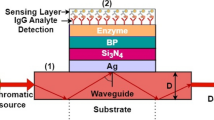Abstract
Here we present a method for selectively and efficiently immobilizing antibodies to enhance the detection performance of surface plasmon resonance immune-sensors (SPRIs) for diagnostic applications. To improve the performance of antibody arrays, protein G was used as antibody-selective linkage layer with aldehyde functionalized poly-(para-xylylene) film. To estimate the efficiency of antibody immobilization, immunoglobulin G (IgG) was measured using the anti-IgG immobilized SPRIs. To demonstrate the proof-of-concept validation, the signal detected from the IgG using parylene-H film was compared with that of a combination of parylene-H and protein G in SPRIs. The results showed that the detection of IgG on the immobilized anti-IgG layer using the combination of parylene-H and protein G has a larger change of signal than that of using parylene-H layer. These results also imply that the anti-IgG was densely and efficiently immobilized on the modified surface with the linkage layer in a combination with parylene-H and protein G. Therefore, we believe that this combinatorial approach could selectively immobilize the antibodies, and also be applied for detection and diagnosis of immune diseases in the field of many SPRIs applications.





Similar content being viewed by others
References
Amit A et al (1986) Three-dimensional structure of an antigen-antibody complex at 2.8 A resolution. Science 233(4765):747–753
Arlett JL, Myers EB, Roukes ML (2011) Comparative advantages of mechanical biosensors. Nat Nanotechnol 6(4):203–215
Bae YM et al (2005) Study on orientation of immunoglobulin G on protein G layer. Biosens Bioelectron 21(1):103–110
Edelman GM (1973) Antibody structure and molecular immunology. Science 180(4088):830–840
Fan X et al (2008) Sensitive optical biosensors for unlabeled targets: a review. Anal Chim Acta 620(1–2):8–26
Fortin JB, Lu TM (2002) A model for the chemical vapor deposition of poly(para-xylylene) (parylene) thin films. Chem Mater 14(5):1945–1949
Fritz J (2008) Cantilever biosensors. Analyst 133(7):855–863
Hanash SM, Pitteri SJ, Faca VM (2008) Mining the plasma proteome for cancer biomarkers. Nature 452(7187):571–579
Ko H et al (2011) One step immobilization of peptides and proteins by using modified parylene with formyl groups. Biosens Bioelectron 30(1):56–60
Lin P-C, Weinrich D, Waldmann H (2010) Protein biochips: oriented surface immobilization of proteins. Macromol Chem Phys 211(2):136–144
Liu C (2007) Recent developments in polymer MEMS. Adv Mater 19(22):3783–3790
Marco M-P, Barceló D (1996) Environmental applications of analytical biosensors. Meas Sci Technol 7(11):1547
Pluchery O, Vayron R, Van K-M (2011) Laboratory experiments for exploring the surface plasmon resonance. Eur J Phys 32(2):585
Prakash S, Karacor MB, Banerjee S (2009) Surface modification in microsystems and nanosystems. Surf Sci Rep 64(7):233–254
Sauer-Eriksson AE et al (1995) Crystal structure of the C2 fragment of streptococcal protein G in complex with the Fc domain of human IgG. Structure 3(3):265–278
Tan CP, Craighead HG (2010) Surface engineering and patterning using parylene for biological applications. Materials 3(3):1803–1832
Thariani R, Yager P (2008) Novel, high-quality surface plasmon resonance microscopy. Sens Actuators B: Chem 130(2):765–770
Tomizaki K-Y, Usui K, Mihara H (2010) Protein–protein interactions and selection: array-based techniques for screening disease-associated biomarkers in predictive/early diagnosis. FEBS J 277(9):1996–2005
Tsai W-C, Pai P-J (2009) Surface plasmon resonance-based immunosensor with oriented immobilized antibody fragments on a mixed self-assembled monolayer for the determination of staphylococcal enterotoxin B. Microchim Acta 166(1–2):115–122
Tsai HY et al (2007) Detection of C-reactive protein based on immunoassay using antibody-conjugated magnetic nanoparticles. Anal Chem 79(21):8416–8419
Wang J (2006) Electrochemical biosensors: towards point-of-care cancer diagnostics. Biosens Bioelectron 21(10):1887–1892
Weiping Q et al (1999) Orientation of antibodies on a 3-aminopropyltriethoxylsilane-modified silicon wafer surface. J Incl Phenom Macrocycl Chem 35(1–2):419–429
Acknowledgments
This work was supported by the National Research Foundation of Korea (NRF) Grant funded by the Korea Government (MEST) [NRF-2011-0014622, A High-throughput Label-free Virus Enumeration and Cryopreservation Technique using Localized Surface Plasmon (LSPR)].
Author information
Authors and Affiliations
Corresponding authors
Rights and permissions
About this article
Cite this article
Shin, E.J., Lee, W.G. & Moon, S.J. Characterization of a novel antibody immobilization combining protein G with parylene-H for surface plasmon resonance immunosensors. Microsyst Technol 22, 2093–2099 (2016). https://doi.org/10.1007/s00542-015-2534-3
Received:
Accepted:
Published:
Issue Date:
DOI: https://doi.org/10.1007/s00542-015-2534-3




